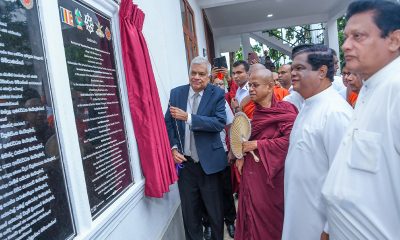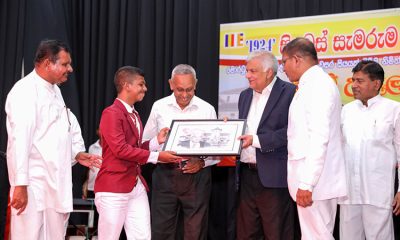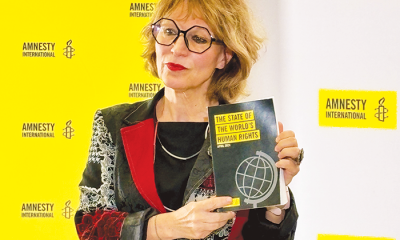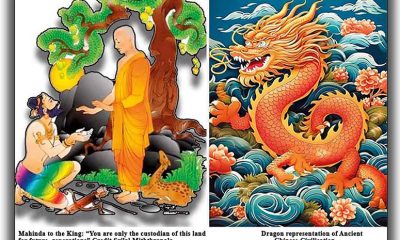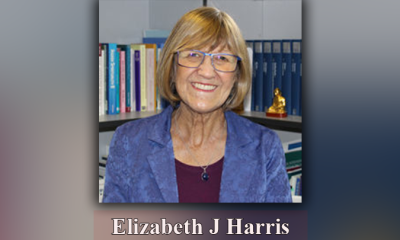Features
Women in Buddhism
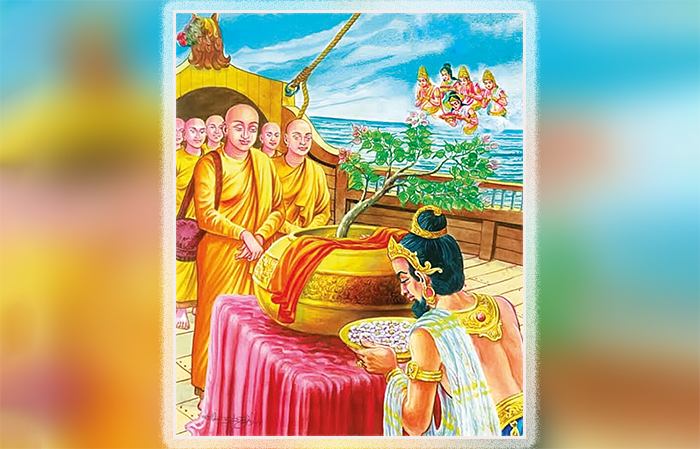
 To me December is the month of women. I am well aware that International Women’s Day falls on March 8 each year since 1975. The theme for International Women’s Day 2023 was: “Count her in: invest in Women.” It is the Universal Declaration of Human Rights that is commemorated on December 10 which was adopted by the UN General Assembly in Paris during its 183rd plenary meeting in 1948.
To me December is the month of women. I am well aware that International Women’s Day falls on March 8 each year since 1975. The theme for International Women’s Day 2023 was: “Count her in: invest in Women.” It is the Universal Declaration of Human Rights that is commemorated on December 10 which was adopted by the UN General Assembly in Paris during its 183rd plenary meeting in 1948.
Notwithstanding, December to me is the month to celebrate women. I presume the reason is that I revere Sanghamitta Theri, daughter of Emperor Asoka, who on request of King Devanampiyatissa on behalf of the women in his court, was sent to Lanka. She brought saplings from the Gaya Bo Tree under which Siddhartha Gautama solved the riddle of samsaric existence and found a solution. She also started the Bhikkhuni Order in this country.
I do not mean to write histories or biographies. Rather do I wish to imagine the emotions felt by the women I respect and include in this article; and what to me is remarkable in their lives. This Sunday is most apt to remember a few chosen women who influenced many, since propitiously the last poya for the year comes right after Christmas. Christmas is a festival celebrated by most persons in Sri Lanka. The next day this year is Duruthu Poya, celebratory for the reason given above. Thus 200–300 BC, women in Lanka were treated equal to men: if bhikkhus were ordained, the privileged choice was given to women too.
Though my title defines women Buddhists, I begin by writing about the respect and reverence I have for Virgin Mary, that most gentle woman who suffered the greatest sorrow of all sorrows, witnessing the death of her son. Mercifully her mourning was short lived since Jesus resurrected himself and ascended to heaven. Another admirable woman at the same time was Mary Magdalene, devoted to merciful Jesus Christ. Having been in a Methodist school; learning Scripture as the timetabled period for learning Christianity was named, and going to Church on Sundays, I learned much. The Bible, particularly the psalms, were studied with pleasure.
Princess Yashodara
Of all women of all time, my most respected wonderful woman is Yashodara, wife at 16 years to Prince Siddartha Gautama of the Sakyan Clan. My admiration was consolidated after seeing the 2018 film Bimba Devi hevath Yashodara scripted and directed by Prof Sunil Ariyaratne. An Indian actor was wisely chosen to play the part of Yashodara – Pallavi Subhash – exquisite and ably capturing the nuances of character of the princess from marriage to old age as a bhikkhuni.
Indian Arpit Choudhary plays Siddhartha. Other actors were all local. It starts with a group of brown clad bhikkhunis walking and Yashodara’s voice comes through, retailing her life and saying she is now close to death and goes to where the Buddha is. Flashbacks screen incidents in the lives of the two.
The most obvious emotions that come to my imagining mind of how she felt, were her love for the person she married, and respect and devotion to the great monk and teacher he became. She was chosen by the Prince from very many young girls, even though unwilling to tie himself down to normal life, having already been disillusioned. But karma determined otherwise. She had been his wife in many previous lives of both.
He told his father Suddodhana and foster mother Prajapati Gotami that he had to leave lay life and go seek the truth of existence when he was to be announced as heir to the Sakyan Principality. The king was angered but Gotami understood him. This same intent told to Yashodara would naturally have saddened her immensely, particularly because it seems to have been when she was pregnant, but she accepted it as destiny decreed. Her only request was that he leave when she was asleep. He did that the day his son was born, whom he named Rahula, knowing that if he stayed longer in lay life, he would not be able to desert his child, bonds becoming stronger.
Anyone can imagine the sorrow and pain of mind Yashodara would have undergone. To me is the additional emotion of deep understanding, empathy towards his need for asceticism, unselfish giving up and resignation to what karma decreed. The Buddha said that we are born of our karma, live by it and die when destined by karma. Thus is seen the metha and karuna in her: all-encompassing love and kindness – two of the Four Brahma Viharas.
When she got news of her husband as a strict ascetic undergoing privations, she resolved to give up luxury living, good food and sleeping comfortably in bed. That demonstrated the deep bond she had with him but minus any clinging or resentment.
When she heard he had gained enlightenment and was a Buddha, she would have felt the third noble feeling of muditha – joy in other’s success – rejoicing he had found the truth of all life – unsatisfactoriness – and defining the Noble Eightfold Path to end it.
The fourth Brahma Vihara she showed as being in her nature was when she pointed to Rahula that the robed monk who came to the Sakyan palace was his father – equanimity or uppeka. Suddodhana was appalled and surely disturbed when he heard his son was going seeking alms with bowl in hand. Not Yashodara.
Retained in her were certain human qualities. To me her staying in her part of the palace without going to meet the Buddha, demonstrated certain pride, maybe doubt whether her husband, now a Buddha, would have foresworn her, and not acknowledge her. He came to her. She fell at his feet and sobbed, it is said. Was it selfishness or a desire to show loss or resentment? I cannot accept that. I feel strongly that her tears were of joy at his having achieved his aim in life and being so humble as to come to her. There may have been sadness too, as the bond of man and wife was rent asunder. She was still a woman with attendant frailaties.
Yashodara became a bhikkhuni after Prajapathi Gotami inaugurated the Order, and it is believed she became an arahnat. She traveled far when old and nearing death to be in the presence of the Buddha. This to me is appreciation, respect and sublime love and devotion.
Two recent Bhikkhunis
I had the great good fortune of getting to know two brown robed ten preceptors in the 1970s: one a German Jew and the other Australian. Ayya Khema used to stay with my kalyanamitta Ratna Dias whenever she left her aranya for Colombo. She then acquired an island in the Ratgama Lake in Dodanduwa in the vicinity of the Island Hermitage and built kutis for visiting seekers of meditation guidance and a dormitory with six rooms.
Once the arrival of foreign seekers dwindled due to the civil war, we local women were afforded open sesame by disciplinarian Ayya Khema. In sharp contrast was Ayya Vayama, very young ten preceptor, who took residence in Parappuduwa Nuns’ Island giving yeoman service in managing the place. They strictly observed all vinaya rules set down by the Buddha – more than for monks.
All others and I respected Ayya Khema very much, even feared her since she never minced words in faulting or advising women who came to her meditation sessions and retreats. But she led hundreds of Sri Lankan, Australians and German women to the Path and was an excellent meditation teacher. She was a doer and leader by nature. She never gave in, particularly to physical frailties.
She had cancer for long and when it troubled her, she went on a water only diet. While residing in Sri Lanka, she received higher ordination in San Francisco and was then referred to as Bhikkhuni Ayya Khema. She returned to Germany to continue her preaching and meditation retreats when she was advised to barbwire the island due to incursion of JVP insurgents. She died in her late 80s of cancer.
Ayya Vayama was long here and became a very close friend of mine. Her adherence to vinaya rules was so strong that she refused even clear soup at night, and never carried money. She went to Amaravati, UK, to proceed on the Path. She was then requested to return to Australia by Ajahn Brahmavamso to start a nuns’ aranya in Perth which she successfully achieved. She was ordained a bhikkhuni by Ajahn Brahm.
Sadly she died prematurely of a nerve ailment which made her wheel chair bound. She radiated metta, truly did so, which was felt by people. Her beliefs and emotions I respectfully discern as unshaken faith in the Buddha, Dhamma, Sangha, and absolute devoutness. Her kindness and concern were all encompassing and she was full of the four Brahma Viharas.
To write about these wonderful dedicated women from the time of the Buddha to the very recent past is certainly gratifying on this day before Duruthu Poya.
Features
The heart-friendly health minister

by Dr Gotabhya Ranasinghe
Senior Consultant Cardiologist
National Hospital Sri Lanka
When we sought a meeting with Hon Dr. Ramesh Pathirana, Minister of Health, he graciously cleared his busy schedule to accommodate us. Renowned for his attentive listening and deep understanding, Minister Pathirana is dedicated to advancing the health sector. His openness and transparency exemplify the qualities of an exemplary politician and minister.
Dr. Palitha Mahipala, the current Health Secretary, demonstrates both commendable enthusiasm and unwavering support. This combination of attributes makes him a highly compatible colleague for the esteemed Minister of Health.
Our discussion centered on a project that has been in the works for the past 30 years, one that no other minister had managed to advance.
Minister Pathirana, however, recognized the project’s significance and its potential to revolutionize care for heart patients.
The project involves the construction of a state-of-the-art facility at the premises of the National Hospital Colombo. The project’s location within the premises of the National Hospital underscores its importance and relevance to the healthcare infrastructure of the nation.
This facility will include a cardiology building and a tertiary care center, equipped with the latest technology to handle and treat all types of heart-related conditions and surgeries.
Securing funding was a major milestone for this initiative. Minister Pathirana successfully obtained approval for a $40 billion loan from the Asian Development Bank. With the funding in place, the foundation stone is scheduled to be laid in September this year, and construction will begin in January 2025.
This project guarantees a consistent and uninterrupted supply of stents and related medications for heart patients. As a result, patients will have timely access to essential medical supplies during their treatment and recovery. By securing these critical resources, the project aims to enhance patient outcomes, minimize treatment delays, and maintain the highest standards of cardiac care.
Upon its fruition, this monumental building will serve as a beacon of hope and healing, symbolizing the unwavering dedication to improving patient outcomes and fostering a healthier society.We anticipate a future marked by significant progress and positive outcomes in Sri Lanka’s cardiovascular treatment landscape within the foreseeable timeframe.
Features
A LOVING TRIBUTE TO JESUIT FR. ALOYSIUS PIERIS ON HIS 90th BIRTHDAY

by Fr. Emmanuel Fernando, OMI
Jesuit Fr. Aloysius Pieris (affectionately called Fr. Aloy) celebrated his 90th birthday on April 9, 2024 and I, as the editor of our Oblate Journal, THE MISSIONARY OBLATE had gone to press by that time. Immediately I decided to publish an article, appreciating the untiring selfless services he continues to offer for inter-Faith dialogue, the renewal of the Catholic Church, his concern for the poor and the suffering Sri Lankan masses and to me, the present writer.
It was in 1988, when I was appointed Director of the Oblate Scholastics at Ampitiya by the then Oblate Provincial Fr. Anselm Silva, that I came to know Fr. Aloy more closely. Knowing well his expertise in matters spiritual, theological, Indological and pastoral, and with the collaborative spirit of my companion-formators, our Oblate Scholastics were sent to Tulana, the Research and Encounter Centre, Kelaniya, of which he is the Founder-Director, for ‘exposure-programmes’ on matters spiritual, biblical, theological and pastoral. Some of these dimensions according to my view and that of my companion-formators, were not available at the National Seminary, Ampitiya.
Ever since that time, our Oblate formators/ accompaniers at the Oblate Scholasticate, Ampitiya , have continued to send our Oblate Scholastics to Tulana Centre for deepening their insights and convictions regarding matters needed to serve the people in today’s context. Fr. Aloy also had tried very enthusiastically with the Oblate team headed by Frs. Oswald Firth and Clement Waidyasekara to begin a Theologate, directed by the Religious Congregations in Sri Lanka, for the contextual formation/ accompaniment of their members. It should very well be a desired goal of the Leaders / Provincials of the Religious Congregations.
Besides being a formator/accompanier at the Oblate Scholasticate, I was entrusted also with the task of editing and publishing our Oblate journal, ‘The Missionary Oblate’. To maintain the quality of the journal I continue to depend on Fr. Aloy for his thought-provoking and stimulating articles on Biblical Spirituality, Biblical Theology and Ecclesiology. I am very grateful to him for his generous assistance. Of late, his writings on renewal of the Church, initiated by Pope St. John XX111 and continued by Pope Francis through the Synodal path, published in our Oblate journal, enable our readers to focus their attention also on the needed renewal in the Catholic Church in Sri Lanka. Fr. Aloy appreciated very much the Synodal path adopted by the Jesuit Pope Francis for the renewal of the Church, rooted very much on prayerful discernment. In my Religious and presbyteral life, Fr.Aloy continues to be my spiritual animator / guide and ongoing formator / acccompanier.
Fr. Aloysius Pieris, BA Hons (Lond), LPh (SHC, India), STL (PFT, Naples), PhD (SLU/VC), ThD (Tilburg), D.Ltt (KU), has been one of the eminent Asian theologians well recognized internationally and one who has lectured and held visiting chairs in many universities both in the West and in the East. Many members of Religious Congregations from Asian countries have benefited from his lectures and guidance in the East Asian Pastoral Institute (EAPI) in Manila, Philippines. He had been a Theologian consulted by the Federation of Asian Bishops’ Conferences for many years. During his professorship at the Gregorian University in Rome, he was called to be a member of a special group of advisers on other religions consulted by Pope Paul VI.
Fr. Aloy is the author of more than 30 books and well over 500 Research Papers. Some of his books and articles have been translated and published in several countries. Among those books, one can find the following: 1) The Genesis of an Asian Theology of Liberation (An Autobiographical Excursus on the Art of Theologising in Asia, 2) An Asian Theology of Liberation, 3) Providential Timeliness of Vatican 11 (a long-overdue halt to a scandalous millennium, 4) Give Vatican 11 a chance, 5) Leadership in the Church, 6) Relishing our faith in working for justice (Themes for study and discussion), 7) A Message meant mainly, not exclusively for Jesuits (Background information necessary for helping Francis renew the Church), 8) Lent in Lanka (Reflections and Resolutions, 9) Love meets wisdom (A Christian Experience of Buddhism, 10) Fire and Water 11) God’s Reign for God’s poor, 12) Our Unhiddden Agenda (How we Jesuits work, pray and form our men). He is also the Editor of two journals, Vagdevi, Journal of Religious Reflection and Dialogue, New Series.
Fr. Aloy has a BA in Pali and Sanskrit from the University of London and a Ph.D in Buddhist Philosophy from the University of Sri Lankan, Vidyodaya Campus. On Nov. 23, 2019, he was awarded the prestigious honorary Doctorate of Literature (D.Litt) by the Chancellor of the University of Kelaniya, the Most Venerable Welamitiyawe Dharmakirthi Sri Kusala Dhamma Thera.
Fr. Aloy continues to be a promoter of Gospel values and virtues. Justice as a constitutive dimension of love and social concern for the downtrodden masses are very much noted in his life and work. He had very much appreciated the commitment of the late Fr. Joseph (Joe) Fernando, the National Director of the Social and Economic Centre (SEDEC) for the poor.
In Sri Lanka, a few religious Congregations – the Good Shepherd Sisters, the Christian Brothers, the Marist Brothers and the Oblates – have invited him to animate their members especially during their Provincial Congresses, Chapters and International Conferences. The mainline Christian Churches also have sought his advice and followed his seminars. I, for one, regret very much, that the Sri Lankan authorities of the Catholic Church –today’s Hierarchy—- have not sought Fr.
Aloy’s expertise for the renewal of the Catholic Church in Sri Lanka and thus have not benefited from the immense store of wisdom and insight that he can offer to our local Church while the Sri Lankan bishops who governed the Catholic church in the immediate aftermath of the Second Vatican Council (Edmund Fernando OMI, Anthony de Saram, Leo Nanayakkara OSB, Frank Marcus Fernando, Paul Perera,) visited him and consulted him on many matters. Among the Tamil Bishops, Bishop Rayappu Joseph was keeping close contact with him and Bishop J. Deogupillai hosted him and his team visiting him after the horrible Black July massacre of Tamils.
Features
A fairy tale, success or debacle

Sri Lanka-Singapore Free Trade Agreement
By Gomi Senadhira
senadhiragomi@gmail.com
“You might tell fairy tales, but the progress of a country cannot be achieved through such narratives. A country cannot be developed by making false promises. The country moved backward because of the electoral promises made by political parties throughout time. We have witnessed that the ultimate result of this is the country becoming bankrupt. Unfortunately, many segments of the population have not come to realize this yet.” – President Ranil Wickremesinghe, 2024 Budget speech
Any Sri Lankan would agree with the above words of President Wickremesinghe on the false promises our politicians and officials make and the fairy tales they narrate which bankrupted this country. So, to understand this, let’s look at one such fairy tale with lots of false promises; Ranil Wickremesinghe’s greatest achievement in the area of international trade and investment promotion during the Yahapalana period, Sri Lanka-Singapore Free Trade Agreement (SLSFTA).
It is appropriate and timely to do it now as Finance Minister Wickremesinghe has just presented to parliament a bill on the National Policy on Economic Transformation which includes the establishment of an Office for International Trade and the Sri Lanka Institute of Economics and International Trade.
Was SLSFTA a “Cleverly negotiated Free Trade Agreement” as stated by the (former) Minister of Development Strategies and International Trade Malik Samarawickrama during the Parliamentary Debate on the SLSFTA in July 2018, or a colossal blunder covered up with lies, false promises, and fairy tales? After SLSFTA was signed there were a number of fairy tales published on this agreement by the Ministry of Development Strategies and International, Institute of Policy Studies, and others.
However, for this article, I would like to limit my comments to the speech by Minister Samarawickrama during the Parliamentary Debate, and the two most important areas in the agreement which were covered up with lies, fairy tales, and false promises, namely: revenue loss for Sri Lanka and Investment from Singapore. On the other important area, “Waste products dumping” I do not want to comment here as I have written extensively on the issue.
1. The revenue loss
During the Parliamentary Debate in July 2018, Minister Samarawickrama stated “…. let me reiterate that this FTA with Singapore has been very cleverly negotiated by us…. The liberalisation programme under this FTA has been carefully designed to have the least impact on domestic industry and revenue collection. We have included all revenue sensitive items in the negative list of items which will not be subject to removal of tariff. Therefore, 97.8% revenue from Customs duty is protected. Our tariff liberalisation will take place over a period of 12-15 years! In fact, the revenue earned through tariffs on goods imported from Singapore last year was Rs. 35 billion.
The revenue loss for over the next 15 years due to the FTA is only Rs. 733 million– which when annualised, on average, is just Rs. 51 million. That is just 0.14% per year! So anyone who claims the Singapore FTA causes revenue loss to the Government cannot do basic arithmetic! Mr. Speaker, in conclusion, I call on my fellow members of this House – don’t mislead the public with baseless criticism that is not grounded in facts. Don’t look at petty politics and use these issues for your own political survival.”
I was surprised to read the minister’s speech because an article published in January 2018 in “The Straits Times“, based on information released by the Singaporean Negotiators stated, “…. With the FTA, tariff savings for Singapore exports are estimated to hit $10 million annually“.
As the annual tariff savings (that is the revenue loss for Sri Lanka) calculated by the Singaporean Negotiators, Singaporean $ 10 million (Sri Lankan rupees 1,200 million in 2018) was way above the rupees’ 733 million revenue loss for 15 years estimated by the Sri Lankan negotiators, it was clear to any observer that one of the parties to the agreement had not done the basic arithmetic!
Six years later, according to a report published by “The Morning” newspaper, speaking at the Committee on Public Finance (COPF) on 7th May 2024, Mr Samarawickrama’s chief trade negotiator K.J. Weerasinghehad had admitted “…. that forecasted revenue loss for the Government of Sri Lanka through the Singapore FTA is Rs. 450 million in 2023 and Rs. 1.3 billion in 2024.”
If these numbers are correct, as tariff liberalisation under the SLSFTA has just started, we will pass Rs 2 billion very soon. Then, the question is how Sri Lanka’s trade negotiators made such a colossal blunder. Didn’t they do their basic arithmetic? If they didn’t know how to do basic arithmetic they should have at least done their basic readings. For example, the headline of the article published in The Straits Times in January 2018 was “Singapore, Sri Lanka sign FTA, annual savings of $10m expected”.
Anyway, as Sri Lanka’s chief negotiator reiterated at the COPF meeting that “…. since 99% of the tariffs in Singapore have zero rates of duty, Sri Lanka has agreed on 80% tariff liberalisation over a period of 15 years while expecting Singapore investments to address the imbalance in trade,” let’s turn towards investment.
Investment from Singapore
In July 2018, speaking during the Parliamentary Debate on the FTA this is what Minister Malik Samarawickrama stated on investment from Singapore, “Already, thanks to this FTA, in just the past two-and-a-half months since the agreement came into effect we have received a proposal from Singapore for investment amounting to $ 14.8 billion in an oil refinery for export of petroleum products. In addition, we have proposals for a steel manufacturing plant for exports ($ 1 billion investment), flour milling plant ($ 50 million), sugar refinery ($ 200 million). This adds up to more than $ 16.05 billion in the pipeline on these projects alone.
And all of these projects will create thousands of more jobs for our people. In principle approval has already been granted by the BOI and the investors are awaiting the release of land the environmental approvals to commence the project.
I request the Opposition and those with vested interests to change their narrow-minded thinking and join us to develop our country. We must always look at what is best for the whole community, not just the few who may oppose. We owe it to our people to courageously take decisions that will change their lives for the better.”
According to the media report I quoted earlier, speaking at the Committee on Public Finance (COPF) Chief Negotiator Weerasinghe has admitted that Sri Lanka was not happy with overall Singapore investments that have come in the past few years in return for the trade liberalisation under the Singapore-Sri Lanka Free Trade Agreement. He has added that between 2021 and 2023 the total investment from Singapore had been around $162 million!
What happened to those projects worth $16 billion negotiated, thanks to the SLSFTA, in just the two-and-a-half months after the agreement came into effect and approved by the BOI? I do not know about the steel manufacturing plant for exports ($ 1 billion investment), flour milling plant ($ 50 million) and sugar refinery ($ 200 million).
However, story of the multibillion-dollar investment in the Petroleum Refinery unfolded in a manner that would qualify it as the best fairy tale with false promises presented by our politicians and the officials, prior to 2019 elections.
Though many Sri Lankans got to know, through the media which repeatedly highlighted a plethora of issues surrounding the project and the questionable credentials of the Singaporean investor, the construction work on the Mirrijiwela Oil Refinery along with the cement factory began on the24th of March 2019 with a bang and Minister Ranil Wickremesinghe and his ministers along with the foreign and local dignitaries laid the foundation stones.
That was few months before the 2019 Presidential elections. Inaugurating the construction work Prime Minister Ranil Wickremesinghe said the projects will create thousands of job opportunities in the area and surrounding districts.
The oil refinery, which was to be built over 200 acres of land, with the capacity to refine 200,000 barrels of crude oil per day, was to generate US$7 billion of exports and create 1,500 direct and 3,000 indirect jobs. The construction of the refinery was to be completed in 44 months. Four years later, in August 2023 the Cabinet of Ministers approved the proposal presented by President Ranil Wickremesinghe to cancel the agreement with the investors of the refinery as the project has not been implemented! Can they explain to the country how much money was wasted to produce that fairy tale?
It is obvious that the President, ministers, and officials had made huge blunders and had deliberately misled the public and the parliament on the revenue loss and potential investment from SLSFTA with fairy tales and false promises.
As the president himself said, a country cannot be developed by making false promises or with fairy tales and these false promises and fairy tales had bankrupted the country. “Unfortunately, many segments of the population have not come to realize this yet”.
(The writer, a specialist and an activist on trade and development issues . )



